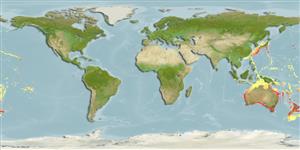Common names from other countries
Élasmobranches (requins et raies) (sharks and rays) >
Squaliformes (Sleeper and dogfish sharks) >
Squalidae (Dogfish sharks)
Etymology: Squalus: Genus name from Latin 'squalus' meaning shark (Ref. 6885, 27436).
More on author: Macleay.
Issue
Junior synonym Squalus acutipinnis Regan, 1908 is considered a valid species in Ref. 109601, 130168.
Environment: milieu / climate zone / depth range / distribution range
Écologie
marin démersal; profondeur 30 - 750 m (Ref. 27121), usually 80 - 300 m (Ref. 57911). Subtropical; 9°C - 23°C (Ref. 57911); 42°N - 60°S, 100°E - 140°W (Ref. 247)
Eastern Indian Ocean: previously considered to be an Australian endemic (Ref. 49645). Eastern Atlantic: confirmed to occur in the Mediterranean (Ref. 93472). Dogfishes presently referred to in current literature as Squalus megalops appear to belong to a complex of similar species. Specimens from the different regions still need to be compared carefully (Ref. 6871).
Length at first maturity / Taille / Poids / Âge
Maturity: Lm 57.0, range 49 - 57 cm
Max length : 72.0 cm TL mâle / non sexé; (Ref. 104718); 89.0 cm TL (female); âge max. reporté: 32 années (Ref. 93445)
Épines dorsales (Total) : 2; Épines anales: 0. A small dogfish with a short, angular snout and a small mouth almost as wide as the snout is long; body without spots; 1st dorsal fin spine over pectoral fins (Ref. 5578). Bronze-grey above, white below; dorsal fins with black tips and white edges but markings inconspicuous in adults (Ref. 5578).
Found on the outer continental shelves and upper slopes, on or near the bottom (Ref. 31367); sublittoral below 130 m (Ref. 11230). Young mostly pelagic off the outer shelves (Ref. 5578). Aggregations by sex are regularly observed (Ref. 6871). Feeds on bony fishes, shrimps and other crustaceans, cephalopods and other elasmobranchs (Ref. 247). Ovoviviparous (Ref. 205), with 2 to 4 young in a litter (Ref. 247). Gestation period is 2 years (Ref. 36731). Utilized for human consumption, the flesh most appealing dried salted or smoked (Ref. 6871). Also consumed fresh (Ref. 31367). Minimum depth reported from Ref. 6808.
Distinct pairing with embrace (Ref. 205). Ovoviviparous, with 2 to 4 young in a litter. Gestation period is about two years. Size at birth 20-24 cm TL (Ref. 6871).
Last, P.R. and J.D. Stevens, 1994. Sharks and rays of Australia. CSIRO, Australia. 513 p. (Ref. 6871)
Statut dans la liste rouge de l'IUCN (Ref. 130435)
CITES (Ref. 128078)
Not Evaluated
Menace pour l'homme
Harmless
Utilisations par l'homme
Pêcheries: commercial; pêche sportive: oui
Outils
Articles particuliers
Télécharger en XML
Sources Internet
Estimates based on models
Preferred temperature (Ref.
115969): 12.8 - 22.8, mean 17.3 (based on 216 cells).
Phylogenetic diversity index (Ref.
82804): PD
50 = 0.5000 [Uniqueness, from 0.5 = low to 2.0 = high].
Bayesian length-weight: a=0.00398 (0.00251 - 0.00631), b=3.07 (2.93 - 3.21), in cm Total Length, based on LWR estimates for this species & Genus-body shape (Ref.
93245).
Niveau trophique (Ref.
69278): 4.3 ±0.3 se; based on diet studies.
Résilience (Ref.
120179): Très faible, temps minimum de doublement de population supérieur à 14 ans (tmax = 32; Fec=2).
Fishing Vulnerability (Ref.
59153): High to very high vulnerability (68 of 100).
